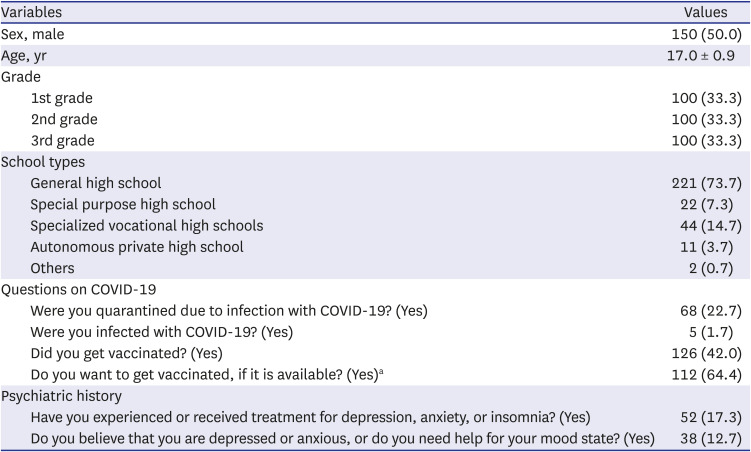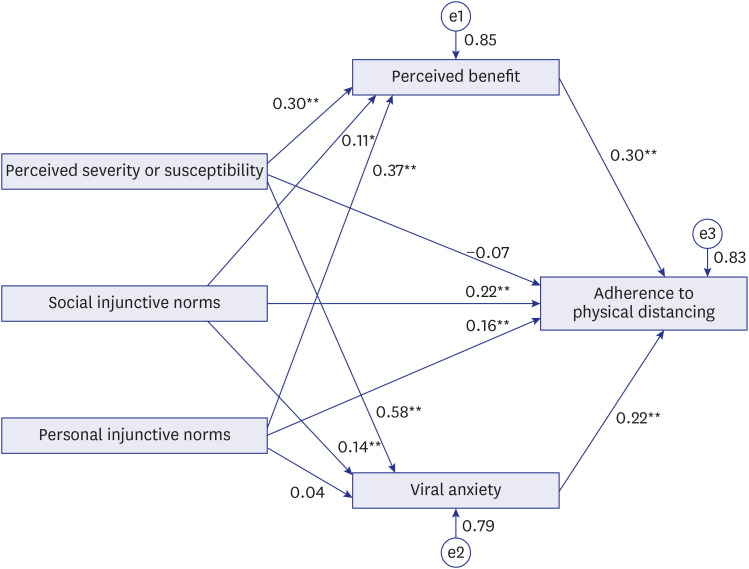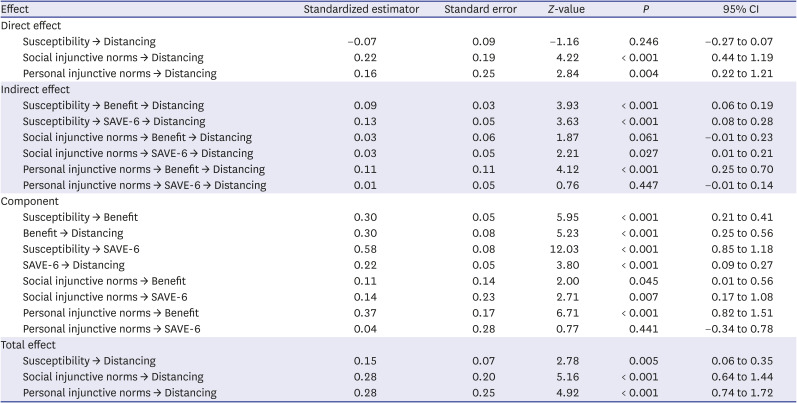1. Buselli R, Corsi M, Baldanzi S, Chiumiento M, Del Lupo E, Dell’Oste V, et al. Professional quality of life and mental health outcomes among health care workers exposed to SARS-CoV-2 (COVID-19). Int J Environ Res Public Health. 2020; 17(17):6180.
2. Shahrabani S, Benzion U, Yom Din G. Factors affecting nurses’ decision to get the flu vaccine. HEPAC Health Econ Prev Care. 2009; 10(2):227–231.
3. Bergwerk M, Gonen T, Lustig Y, Amit S, Lipsitch M, Cohen C, et al. Covid-19 breakthrough infections in vaccinated health care workers. N Engl J Med. 2021; 385(16):1474–1484. PMID:
34320281.
4. Girum T, Lentiro K, Geremew M, Migora B, Shewamare S, Shimbre MS. Optimal strategies for COVID-19 prevention from global evidence achieved through social distancing, stay at home, travel restriction and lockdown: a systematic review. Arch Public Health. 2021; 79(1):150. PMID:
34419145.
5. Liu H, Chen C, Cruz-Cano R, Guida JL, Lee M. Public Compliance with social distancing measures and SARS-CoV-2 spread: a quantitative analysis of 5 states. Public Health Rep. 2021; 136(4):475–482. PMID:
33909541.
6. Wasserman D, van der Gaag R, Wise J. The term “physical distancing” is recommended rather than “social distancing” during the COVID-19 pandemic for reducing feelings of rejection among people with mental health problems. Eur Psychiatry. 2020; 63(1):e52. PMID:
32475365.
7. Weill JA, Stigler M, Deschenes O, Springborn MR. Social distancing responses to COVID-19 emergency declarations strongly differentiated by income. Proc Natl Acad Sci U S A. 2020; 117(33):19658–19660. PMID:
32727905.
8. Soltanian AR, Omidi T, Khazaei S, Bashirian S, Heidarimoghadam R, Jenabi E, et al. Assessment of mask-wearing adherence and social distancing compliance in public places in Hamadan, Iran, during the COVID-19 pandemic. J Res Health Sci. 2021; 21(3):e00526. PMID:
34698660.
9. Zang E, West J, Kim N, Pao C. U.S. regional differences in physical distancing: Evaluating racial and socioeconomic divides during the COVID-19 pandemic. PLoS One. 2021; 16(11):e0259665. PMID:
34847174.
10. Tong KK, Chen JH, Yu EW, Wu AM. Adherence to COVID-19 precautionary measures: applying the health belief model and generalised social beliefs to a probability community sample. Appl Psychol Health Well-Being. 2020; 12(4):1205–1223. PMID:
33010119.
11. Rosenstock IM. The health belief model: Explaining health behavior through expectancies. Glanz K, Lewis FM, Rimer BK, editors. Health Behavior and Health Education: Theory, Research, and Practice. The Jossey-Bass Health Series. Hoboken, NJ, USA: Jossey-Bass/Wiley;1990. p. 39–62.
12. Brewer NT, Chapman GB, Gibbons FX, Gerrard M, McCaul KD, Weinstein ND. Meta-analysis of the relationship between risk perception and health behavior: the example of vaccination. Health Psychol. 2007; 26(2):136–145. PMID:
17385964.
13. Cialdini RB, Goldstein NJ. Social influence: compliance and conformity. Annu Rev Psychol. 2004; 55(1):591–621. PMID:
14744228.
14. Rivis A, Sheeran P. Descriptive norms as an additional predictor in the theory of planned behaviour: A meta-analysis. Curr Psychol. 2003; 22(3):218–233.
15. Manstead ASR. The role of moral norm in the attitude–behavior relation. Terry DJ, Hogg MA, editors. Attitudes, Behavior, and Social Context: The Role of Norms and Group Membership. Mahwah, NJ, USA: Lawrence Erlbaum Associates;1999. p. 11–30.
16. Byun S, Slavin RE. Educational responses to the COVID-19 outbreak in South Korea. Best Evid Chin Edu. 2020; 5(2):665–680.
17. Thakur A. Mental health in high school students at the time of COVID-19: a student’s perspective. J Am Acad Child Adolesc Psychiatry. 2020; 59(12):1309–1310. PMID:
32860905.
18. Igra V, Irwin CE Jr. Theories of adolescent risk-taking behavior. DiClemente RJ, Hansen WB, Ponton LE, editors. Handbook of Adolescent Health Risk Behavior. Cleveland, OH, USA: Plenum Press;1996. p. 35–51.
19. Eysenbach G. Improving the quality of web surveys: the Checklist for Reporting Results of Internet E-Surveys (CHERRIES). J Med Internet Res. 2004; 6(3):e34. PMID:
15471760.
20. Cohen J. Statistical Power Analysis for the Behavioral Sciences. 2nd ed. Mahwah, NJ, USA: Lawrence Erlbaum Associates;1988.
21. Gouin JP, MacNeil S, Switzer A, Carrese-Chacra E, Durif F, Knäuper B. Socio-demographic, social, cognitive, and emotional correlates of adherence to physical distancing during the COVID-19 pandemic: a cross-sectional study. Can J Public Health. 2021; 112(1):17–28. PMID:
33464556.
22. Chung S, Ahn MH, Lee S, Kang S, Suh S, Shin YW. The Stress and Anxiety to Viral Epidemics-6 Items (SAVE-6) scale: a new instrument for assessing the anxiety response of general population to the viral epidemic during the COVID-19 pandemic. Front Psychol. 2021; 12:669606. PMID:
34149565.
23. Kroenke K, Spitzer RL, Williams JB. The PHQ-9: validity of a brief depression severity measure. J Gen Intern Med. 2001; 16(9):606–613. PMID:
11556941.
24. Park SJ, Choi HR, Choi JH, Kim K, Hong JP. Reliability and validity of the Korean version of the patient health questionnaire-9 (PHQ-9). Anxiety Mood. 2010; 6(2):119–124.
25. Diener E, Emmons RA, Larsen RJ, Griffin S. The satisfaction with life scale. J Pers Assess. 1985; 49(1):71–75. PMID:
16367493.
26. Jeong HS, Kang I, Namgung E, Im JJ, Jeon Y, Son J, et al. Validation of the Korean version of the Connor-Davidson Resilience Scale-2 in firefighters and rescue workers. Compr Psychiatry. 2015; 59:123–128. PMID:
25744698.
27. Brown TA. Confirmatory Factor Analysis for Applied Research. New York, NY, USA: Guilford Press;2006.
28. Byrne BM. Structural Equation Modeling with AMOS: Basic Concepts, Applications, and Programming. Mahwah, NJ, USA: Lawrence Erlbaum Associates;2001.
29. Hounton SH, Carabin H, Henderson NJ. Towards an understanding of barriers to condom use in rural Benin using the Health Belief Model: a cross sectional survey. BMC Public Health. 2005; 5(1):8. PMID:
15663784.
30. Alberts A, Elkind D, Ginsberg S. The personal fable and risk-taking in early adolescence. J Youth Adolesc. 2007; 36(1):71–76.
31. Schultz PW, Nolan JM, Cialdini RB, Goldstein NJ, Griskevicius V. The constructive, destructive, and reconstructive power of social norms. Psychol Sci. 2007; 18(5):429–434. PMID:
17576283.
32. Shapiro JP, Baumeister RF, Kessler JW. A three-component model of children’s teasing: Aggression, humor, and ambiguity. J Soc Clin Psychol. 1991; 10(4):459–472.
33. Krekel C, Swanke S, De Neve JE, Fancourt D. IZA DP No. 13690. Are Happier People More Compliant? Global Evidence from Three Large-Scale Surveys during COVID-19 Lockdowns. Bonn, Germany: IZA Institute of Labor Economics;2020.
34. Stickley A, Matsubayashi T, Sueki H, Ueda M. COVID-19 preventive behaviours among people with anxiety and depressive symptoms: findings from Japan. Public Health. 2020; 189:91–93. PMID:
33189941.
35. Wright L, Steptoe A, Fancourt D. Predictors of self-reported adherence to COVID-19 guidelines. A longitudinal observational study of 51,600 UK adults. Lancet Reg Health Eur. 2021; 4:100061. PMID:
33997831.
36. Seo YM, Choi WH. COVID-19 prevention behavior and its affecting factors in high school students. Korean J Health Serv Manag. 2020; 14(4):215–225.
37. Ryan RG. Age differences in personality: adolescents and young adults. Pers Individ Dif. 2009; 47(4):331–335.
38. Kelley AE, Schochet T, Landry CF. Risk taking and novelty seeking in adolescence: introduction to part I. Ann N Y Acad Sci. 2004; 1021(1):27–32. PMID:
15251871.
39. World Health Organization. Pandemic Fatigue: Reinvigorating the Public to Prevent COVID-19: Policy Framework for Supporting Pandemic Prevention and Management: Revised Version November 2020. Copenhagen, Denmark: World Health Organization. Regional Office for Europe;2020.
40. Acquah EO, Wilson ML, Doku DT. Patterns and correlates for bullying among young adolescents in Ghana. Soc Sci. 2014; 3(4):827–840.
41. Bastiaensens S, Pabian S, Vandebosch H, Poels K, Van Cleemput K, DeSmet A, et al. From normative influence to social pressure: how relevant others affect whether bystanders join in cyberbullying. Soc Dev. 2016; 25(1):193–211.
42. Chung S, Kim HJ, Ahn MH, Yeo S, Lee J, Kim K, et al. Development of the Stress and Anxiety to Viral Epidemics-9 (SAVE-9) Scale for assessing work-related stress and anxiety in healthcare workers in response to viral epidemics. J Korean Med Sci. 2021; 36(47):e319. PMID:
34873885.









 PDF
PDF Citation
Citation Print
Print




 XML Download
XML Download